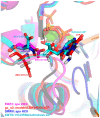Activity of Selected Nucleoside Analogue ProTides against Zika Virus in Human Neural Stem Cells
- PMID: 31010044
- PMCID: PMC6521205
- DOI: 10.3390/v11040365
Activity of Selected Nucleoside Analogue ProTides against Zika Virus in Human Neural Stem Cells
Abstract
Zika virus (ZIKV), an emerging flavivirus that causes neurodevelopmental impairment to fetuses and has been linked to Guillain-Barré syndrome continues to threaten global health due to the absence of targeted prophylaxis or treatment. Nucleoside analogues are good examples of efficient anti-viral inhibitors, and prodrug strategies using phosphate masking groups (ProTides) have been employed to improve the bioavailability of ribonucleoside analogues. Here, we synthesized and tested a small library of 13 ProTides against ZIKV in human neural stem cells. Strong activity was observed for 2'-C-methyluridine and 2'-C-ethynyluridine ProTides with an aryloxyl phosphoramidate masking group. Substitution of a 2-(methylthio) ethyl phosphoramidate for the aryloxyl phosphoramidate ProTide group of 2'-C-methyluridine completely abolished antiviral activity of the compound. The aryloxyl phosphoramidate ProTide of 2'-C-methyluridine outperformed the hepatitis C virus (HCV) drug sofosbuvir in suppression of viral titers and protection from cytopathic effect, while the former compound's triphosphate active metabolite was better incorporated by purified ZIKV NS5 polymerase over time. These findings suggest both a nucleobase and ProTide group bias for the anti-ZIKV activity of nucleoside analogue ProTides in a disease-relevant cell model.
Keywords: NS5; ProTides; RNA-dependent RNA polymerase; Zika virus; antiviral agents; neural stem cells; nucleoside analogues; prodrugs.
Conflict of interest statement
The authors declare no conflict of interest. The funders had no role in the design of the study; in the collection, analyses, or interpretation of data; in the writing of the manuscript, or in the decision to publish the results.
Figures






Similar articles
-
In Vitro and In Vivo Characterization of the Anti-Zika Virus Activity of ProTides of 2'-C-β-Methylguanosine.ACS Infect Dis. 2020 Jul 10;6(7):1650-1658. doi: 10.1021/acsinfecdis.0c00091. Epub 2020 Jun 19. ACS Infect Dis. 2020. PMID: 32525653
-
Novel Nucleoside Analogues as Effective Antiviral Agents for Zika Virus Infections.Molecules. 2020 Oct 20;25(20):4813. doi: 10.3390/molecules25204813. Molecules. 2020. PMID: 33092055 Free PMC article.
-
Purification of Zika virus RNA-dependent RNA polymerase and its use to identify small-molecule Zika inhibitors.J Antimicrob Chemother. 2017 Mar 1;72(3):727-734. doi: 10.1093/jac/dkw514. J Antimicrob Chemother. 2017. PMID: 28069884 Free PMC article.
-
Phosphoramidates and phosphonamidates (ProTides) with antiviral activity.Antivir Chem Chemother. 2018 Jan-Dec;26:2040206618775243. doi: 10.1177/2040206618775243. Antivir Chem Chemother. 2018. PMID: 29792071 Free PMC article. Review.
-
Advanced Prodrug Strategies in Nucleoside and Non-Nucleoside Antiviral Agents: A Review of the Recent Five Years.Molecules. 2017 Oct 16;22(10):1736. doi: 10.3390/molecules22101736. Molecules. 2017. PMID: 29035325 Free PMC article. Review.
Cited by
-
Antiviral Agents: Discovery to Resistance.Viruses. 2020 Apr 7;12(4):406. doi: 10.3390/v12040406. Viruses. 2020. PMID: 32272550 Free PMC article.
-
Recent Advances in Antivirals for Japanese Encephalitis Virus.Viruses. 2023 Apr 23;15(5):1033. doi: 10.3390/v15051033. Viruses. 2023. PMID: 37243122 Free PMC article. Review.
-
Therapeutic Advances Against ZIKV: A Quick Response, a Long Way to Go.Pharmaceuticals (Basel). 2019 Aug 30;12(3):127. doi: 10.3390/ph12030127. Pharmaceuticals (Basel). 2019. PMID: 31480297 Free PMC article. Review.
-
Recent advances in the study of zika virus structure, drug targets, and inhibitors.Front Pharmacol. 2024 Jul 1;15:1418516. doi: 10.3389/fphar.2024.1418516. eCollection 2024. Front Pharmacol. 2024. PMID: 39011504 Free PMC article. Review.
-
Advance of structural modification of nucleosides scaffold.Eur J Med Chem. 2021 Mar 15;214:113233. doi: 10.1016/j.ejmech.2021.113233. Epub 2021 Jan 30. Eur J Med Chem. 2021. PMID: 33550179 Free PMC article. Review.
References
-
- De Araújo T.V.B., de Alencar Ximenes R.A., de Barros Miranda-Filho D., Souza W.V., Montarroyos U.R., de Melo A.P.L., Valongueiro S., Braga C., Brandão Filho S.P., Cordeiro M.T., et al. Association between microcephaly, Zika virus infection, and other risk factors in Brazil: Final report of a case-control study. Lancet Infect. Dis. 2018;18:328–336. - PMC - PubMed
-
- Ferrero D., Ferrer-Orta C., Verdaguer N. Viral RNA-Dependent RNA Polymerases: A Structural Overview. Subcell. Biochem. 2018;88:39–71. - PubMed
Publication types
MeSH terms
Substances
Grants and funding
LinkOut - more resources
Full Text Sources
Medical
Research Materials

